US warship challenges China’s territorial water claims in ‘freedom of navigation’ sail-by – reports

The USS Dewey guided missile destroyer has reportedly sailed within 12 nautical miles of the Spratly Islands in the South China Sea, apparently challenging Beijing’s sovereignty claims over disputed island chain.
UPDATE: China warns ‘unpermitted’ US patrol to leave disputed waters in S. China Sea
The US warship passed near Mischief Reef in the Spratly Islands on Wednesday under the “Freedom of Navigation” principle, according to Wall Street Journal and Reuters sources.
If indeed the USS Dewey sailed within 12 nautical miles of the disputed land, then Washington seemingly violated China's territorial claims. Territorial waters are defined by the 1982 United Nations Convention on the Law of the Sea as a belt of coastal waters extending 12 nautical miles from the coast.
Wednesday’s freedom of navigation sail was the United States’ first since October and the first since Donald Trump took office in January.
In a statement to The Japan Times, the Pentagon refused to confirm or deny the report. The Wall Street Journal also failed to get a definitive answer from the Pentagon.
“We operate in the Asia-Pacific region on a daily basis, including in the South China Sea,” Capt. Jeff Davis, a Pentagon spokesman, told the publication in a statement.
“We operate in accordance with international law,” he added, emphasizing the patrols are “not about any one country, or any one body of water.”
While the Pentagon is reluctant to confirm the reports, photos posted on Commander – the US’ Third Fleet Facebook page – appeared to show the US vessel sailing the disputed waters. “USS Dewey (DDG 105) transits the South China Sea before a replenishment-at-sea with USNS Pecos (T-AO-197),” the picture post reads.
Earlier this month, US Navy Commander Gary Ross revealed that Washington is looking to continue its Freedom of Navigation operations in the disputed South China Sea region under Trump’s administration.
“We are continuing with regular FONOPs (Freedom of Navigation operations), as we have routinely done in the past and will continue to do in the future,” Ross was quoted as saying.
The alleged intrusion into the disputed waters comes at a delicate time when Trump is seeking Xi Jinping’s cooperation to resolve North Korea’s nuclear and ballistic missile question. While Beijing has yet to issue a comment regarding the latest incident, China has strongly condemned such actions in the past.
China says it respects the principles of freedom of navigation and overflight but disapproves when other states undermine its sovereignty using this pretext.
Beijing has laid claim to nearly all of the resource-rich South China Sea, through which some $5 trillion worth of trade passes each year. The Spratly Islands, or Spratlys, comprising more than 750 islets, atolls, and reefs, have also been caught up in the multinational dispute, with the claimants having their own national names for the archipelago.
The United States has repeatedly criticized China’s reclamation of land in the Spratly chain as well as the buildup of military facilities on these islets, voicing concern that they could be used to restrict free movement in the area.













